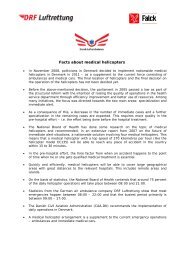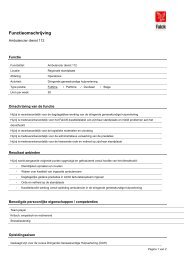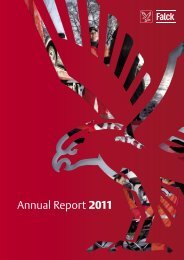Annual Report 2010 - Falck
Annual Report 2010 - Falck
Annual Report 2010 - Falck
You also want an ePaper? Increase the reach of your titles
YUMPU automatically turns print PDFs into web optimized ePapers that Google loves.
62 <strong>Falck</strong> <strong>Annual</strong> <strong>Report</strong> <strong>2010</strong> | Group<br />
Notes to the Group financial statements<br />
Note<br />
1 Accounting policies (continued)<br />
Other operating equipment is depreciated on a straight-line basis<br />
over the estimated useful lives of the assets. The expected<br />
useful lives are as follows:<br />
Years<br />
Vehicles according to category 5-12<br />
Fixtures and fittings, tools and equipment 3-10<br />
Dispatch centres, radio systems, major administrative<br />
systems and networks 8<br />
Other IT equipment 3-5<br />
Fire extinguishers and similar equipment<br />
installed at customer locations 3-5<br />
Assets held under finance leases are recognised under property,<br />
plant and equipment and measured at the lower of the fair<br />
value and value in use of the future lease payments at the<br />
inception of the lease.<br />
Assets held under finance leases are depreciated over the useful<br />
lives of the assets or, if shorter, over the lease term.<br />
Gains or losses on the disposal or scrapping of property, plant<br />
and equipment are determined as the difference between the<br />
sales price less dismantling, selling and re-establishing costs<br />
and the carrying amount. Any gains or losses are recognised in<br />
the income statement as other operating income or external<br />
expenses respectively.<br />
Financial assets<br />
Investments in subsidiaries and associates in the parent company’s<br />
financial statements are measured at cost less any<br />
impairment losses. Where the carrying amount exceeds the<br />
recoverable amount, the investments are written down to this<br />
lower value.<br />
Investments in associates in the consolidated financial statements<br />
are measured using the equity method and recognised<br />
at the proportionate share of the equity of the relevant enterprise,<br />
made up according to the Group’s accounting policies,<br />
with the addition of values added on acquisition, including<br />
goodwill. Investments in associates are tested for impairment<br />
when there is an indication that the investment may be<br />
impaired. Associates with negative equity value are measured<br />
at zero value. If the Group has a legal or constructive obligation<br />
to cover the associate’s negative balance, such obligation<br />
is recognised under liabilities. Receivables from associates are<br />
measured at amortised cost. Provision is made for bad debts.<br />
CURRENT ASSETS<br />
Inventories<br />
Goods purchased for resale and assistive aids are measured at<br />
cost using the FIFO method.<br />
Where the net realisable value is lower than cost, inventories<br />
are written down to this lower value.<br />
Receivables<br />
Receivables are measured at amortised cost less provision<br />
for bad debts. The provision is made individually and on a<br />
portfolio level. If there is an objective indication that an individual<br />
receivable may be impaired, a write-down is made on<br />
an individual level. In the event there is no objective indication<br />
of individual impairment, receivables are tested for objective<br />
indications of impairment on a portfolio level.<br />
Impairment losses are calculated as the difference between<br />
the carrying amount and the present value of expected<br />
future cash flows, including realisable values of any collateral<br />
provided.<br />
Prepayments<br />
Prepayments comprise prepaid costs, which are measured at<br />
amortised cost.<br />
Securities<br />
Listed securities and unlisted securities, which are currently all<br />
classified as available for sale, are recognised under current assets<br />
at fair value, corresponding to the officially quoted price<br />
of listed securities and estimated fair values based on current<br />
market data and recognised valuation methods for unlisted<br />
securities. Unrealised fair value adjustments are recognised<br />
directly in equity, except for impairment losses, which are<br />
recognised in the income statement under financials. On<br />
realisation, the accumulated fair value adjustment recognised<br />
in equity is transferred to financials in the income statement.<br />
EQUITY<br />
Dividend<br />
Dividend that has been finally adopted is recognised as a<br />
liability. Dividend expected to be paid in respect of the year is<br />
recognised as a separate line item under equity.
















